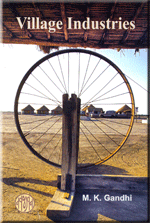
P.O. SEVAGRAM, DIST.WARDHA 442102, MS, INDIA. Phone: 91-7152-284753
FOUNDED BY MAHATMA GANDHI IN 1936
Village Industries

VILLAGE INDUSTRIES
Written by :M. K. Gandhi
Table of Contents
- Why The Village Industries Movement
- Causes of Decline of Village Industries
- Dangers of Mechanization
- Rehabilitation of Village Industries
- Difficulties in The Way
- Pattern of State Assistance
- Spinning Wheel : The Life-Giving Sun
- Tanning
- Dairying
- Gur and Khandsari
- Other Village Industries
- Village Exhibitions
About This Book
Written by : M. K. Gandhi
Edited by : Bharatan Kumarappa
First Edition : 10,000 copies, April 1960
I.S.B.N : 81-7229-121-3
Printed and Published by : Jitendra T. Desai
Navajivan Mudranalaya,
Ahmedabad - 380 014,
India.
© Navajivan Trust, 1960
Download
Chapter-6: Pattern of State Assistance
A suggestion has been made that there should be a separate minister for the work, as, for proper organization, it will occupy all the time of one minister. I dread to make the suggestion, for we have not yet outlived the English scale of expenditure. Whether a minister is separately appointed or not, a department for the work is surely necessary. In these times of scarcity of food and clothing, this department can render the greatest help. The ministers have experts at their disposal through the A. I. S. A. and the A. I. V. I. A. It is possible to clothe today the whole of India in Khadi on the smallest outlay and in the shortest time possible. Each provincial Government has to tell the villagers that they must manufacture their own Khaddar for their own use. This brings in automatic local production and distribution. And there will undoubtedly be a surplus for the cities at least to a certain extent which, in its turn, will reduce the pressure on the local mills. The latter will then be able to take part in supplying the want of cloth in other parts of the world.
How can this result be brought about?
The Governments should notify the villagers that they will be expected to manufacture Khaddar for the needs of their village within a fixed date after which no cloth will be supplied to them. The Governments in their turn will supply the villagers with cotton seed or cotton wherever required, at cost price and the tools of manufacture also at cost, to be recovered in easy installments payable in, say, five years or more. They will supply them with instructors wherever necessary and undertake to buy surplus stock of Khaddar, provided that the villagers in question have their cloth requirements supplied from their own manufacture. This should do away with cloth shortage without fuss and with very little overhead charges.
The villages will be surveyed and a list prepared of things that can be manufactured locally with little or no help and which may be required for village use or for sale outside, such for instance, as ghani- pressed oil and cakes, burning oil prepared through ghanis, hand-pounded rice, tadgur, honey, toys, mats, hand-made paper, village soap, etc. If enough care is thus taken the villages, most of them as good as dead or dying, will hum with life and exhibit the immense possibilities they have of supplying most of their wants themselves and of the cities and towns of India.
Then there is the limitless cattle wealth of India suffering from criminal neglect. Goseva Sangh, as yet not properly experienced, can still supply valuable aid.
Without the basic training the villagers are being starved for education. This desideratum can be supplied by the Hindustani Talimi Sangh.
Harijan, 28-4-1946